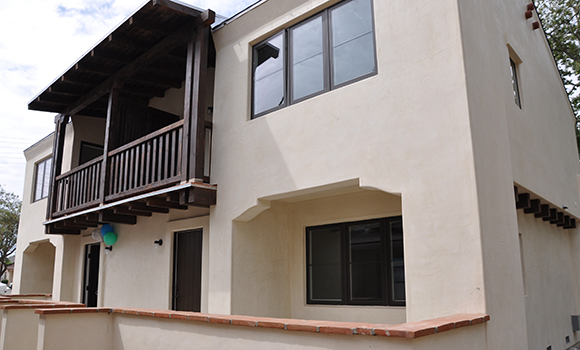
Sycamore Gardens affordable housing apartments in Santa Barbara. (Photo Credit: Housing Authority of the City of Santa Barbara)
Nestled between the Pacific Ocean and the Santa Ynez Mountains, Santa Barbara is known as “The American Rivera.” It is an international tourist destination, boasting world-class resorts, restaurants and shopping, as well as numerous outdoor activities and the starting point for many exploring the Central Coast’s famous wine country.
But Santa Barbara is also one of the most expensive places to live in the country. Because of its geography, there is limited space and that has created a housing crunch, making it hard for many working in the region’s service industry to afford housing. The median home costs more than $1.7 million and the average rent for a two bedroom apartment is $2,500, yet the median income for a family of four is $77,100.
“Everybody wants to come to Santa Barbara to vacation, so there are a lot of low-wage income earners in the service industry who need help,” said Rob Fredericks, deputy executive director and CAO for the Housing Authority of the City of Santa Barbara. “We have a 6,493 applicants for our Section 8 voucher program. So we know the need is huge for affordable housing and it’s growing, not diminishing.”
Recognizing the need, last month the Housing Authority closed escrow on two former public housing properties, Pearl Gardens and Sycamore Gardens, which will be rehabilitated into affordable housing. The project is a public-private project made possible through the HUD Rental Assistance Demonstration program and the Federal Low-Income Housing Tax Credit Program.
“Pearl and Sycamore Gardens are two jewels in our inventory as far as being large family units with three and four bedroom units,” explained Fredericks. “The families that are struggling earning lower income, lower wages need help as well and we’ve had these in our inventory as public housing for quite some time.”
The renovations are scheduled for completion by the end of this year. And when they open, Pearl Gardens will have 15 family units with three or four bedrooms, onsite parking, patios and a play area for children. Sycamore Gardens will have 20 three-bedroom townhouses with parking, open space and on-site laundry facilities. Both properties have easy access to local transit and are close to schools and other services.
The geography of the City of Santa Barbara leaves little room for new development. “We’re bounded by the ocean on two sides and the other side is the mountain range, so between the mountains and the ocean. We’re built out,” said Fredericks. “We have to look at ways of preserving what we have built already and that’s what we’re doing with Pearl Gardens and Sycamore Gardens.”
Local employees who cannot afford market-rate rents or cannot find affordable housing often have long commutes of an hour or more each way.
With so many people in that situation, the City of Santa Barbara has taken steps to help its workforce live in the same community as their jobs. In 2013, the city council approved the Average Unit-Size Density Incentive Program, which encourages developers to build smaller, more affordable units in designated areas, near transit and within walking or biking distance to services. The program’s initial duration is for eight years or until 250 units have been built. To date, 209 units have been approved under this program.
The city also has an ordinance that helps keep condominium conversions affordable, if tenants have met an income and residency threshold. Additionally, it has an inclusionary policy that requires 15 percent of newly built units or condominium conversions be sold at prices affordable to middle-income buyers.
Santa Barbara’s Pearl Gardens and Sycamore Gardens are an example of how local agencies can create housing for middle- and low-income residents even in a challenging economic environment. The City has built a framework with incentives for developers to build affordable units close to both transportation and worksites. It is a step toward the goal set by the California Economic Summit of creating one million middle- and low-income housing units within the next decade.
Fredericks summed up why affordable housing is important to his community: “If we can keep people here, where they work, it’s a healthier environment all the way around.”

